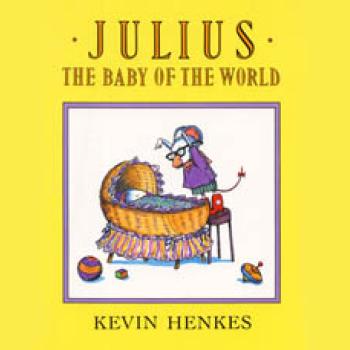Text Talk: Julius, the Baby of the World

- Preview |
- Standards |
- Resources & Preparation |
- Instructional Plan |
- Related Resources |
- Comments
Overview
The importance of reading aloud to children is an established tenet of reading instruction. This lesson supports the language development and reading comprehension of kindergarten through second graders. Through the use of the text talk strategy, students explain, develop, and expand story ideas. This lesson is designed to help students learn how to gain meaning from words that are taken out of their original context.
From Theory to Practice
- Text talk interactions are based on open-ended questions that the teacher poses during reading that ask children to consider the ideas in the story and talk about and connect them as the story moves along.
- Text talks have six components:
| 1. | Selecting texts that have some complexities of events for children to build meaning |
| 2. | Interspersed open-ended questions that require students to explain and describe text ideas |
| 3. | Follow-up questions that encourage elaboration of initial ideas |
| 4. | Pictures, which are presented after students have responded to the text |
| 5. | Background knowledge, which is used to support meaning building |
| 6. | Vocabulary words, which engage students in direct discussion after the story is completed |
Common Core Standards
This resource has been aligned to the Common Core State Standards for states in which they have been adopted. If a state does not appear in the drop-down, CCSS alignments are forthcoming.
State Standards
This lesson has been aligned to standards in the following states. If a state does not appear in the drop-down, standard alignments are not currently available for that state.
NCTE/IRA National Standards for the English Language Arts
- 1. Students read a wide range of print and nonprint texts to build an understanding of texts, of themselves, and of the cultures of the United States and the world; to acquire new information; to respond to the needs and demands of society and the workplace; and for personal fulfillment. Among these texts are fiction and nonfiction, classic and contemporary works.
- 11. Students participate as knowledgeable, reflective, creative, and critical members of a variety of literacy communities.
- 12. Students use spoken, written, and visual language to accomplish their own purposes (e.g., for learning, enjoyment, persuasion, and the exchange of information).
Materials and Technology
- Julius, the Baby of the World by Kevin Henkes
- Index cards
- Pocket chart
Preparation
| 1. | Before reading the story aloud, review the discussion questions and vocabulary words as noted in the INSTRUCTION AND ACTIVITIES. |
| 2. | Write the vocabulary words on index cards to display in a pocket chart. |
Student Objectives
Students will
- Respond to open-ended questions using support from language in the text
- Interpret story elements based on textual language
- Use context clues to help define story vocabulary
Session 1
Begin by introducing the story and showing students the front cover of the book Julius, the Baby of the World. Tell students that you would like them to listen to the story; however, you will not be showing them all of the pictures. Use the following questions throughout the story to prompt development of meaning and discussion:
- Before reading: Ask students what they think about the front cover. Which one do you think is Julius? Who is the person in the mask?
- Page 1: How can Lily do these things before Julius was born? Revisit the characters on the cover. Who do you think the characters are now?
- Pages 2-3: How does Lily feel about her little brother? How do you know?
- Pages 4-9: Why do you think Lily's parents do not want to leave her alone with Julius? Do you think Lily liked being alone with Julius? Why or why not?
- Pages 10-13: Why did Lily's parents treat her and Julius differently when they did the same things (e.g., blowing bubbles, gurgling)?
- Page 14: What do you think is the uncooperative chair?
- Pages 15-16: Do you think Julius' invitation really got lost in the mail? How do you know?
- Pages 17-22: Why do you think Lily's parents did nice things for her? Why didn't it work?
- Page 23-end: Why did Lily get upset when Cousin Garland said Julius was disgusting?
- Follow-up questions: Why do you think Lily liked Julius at the end? Do you think they will stay friends?
Session 2
| 1. | Begin the lesson by discussing the story and questions from the previous session. You may want to reread the story. |
| 2. | Display the following vocabulary words in a pocket chart: insulting chimed constantly clever doubtful dazzling uncooperative |
| 3. | Read the words aloud to students. Then reread the sentence where each word appears in the story. Ask students what clues the story gives about the meaning of the word. Discuss possible meanings and give students the correct meaning. Ask students to give an example of another situation where they might use or see the word.Example: insulting
|
Extensions
To extend this story, visit the Kevin Henkes' website for background information on the author, coloring pages, and activity ideas.
Student Assessment / Reflections
To assess students' learning, take anecdotal notes based on their comments and discussion. Some guiding questions may include:
- Are students using the language of the story to make interpretations?
- Are students going beyond the immediate events of the story to make deductions and draw conclusions?
- Are students building meaning based on the text rather than relying too much on their prior knowledge?
- Were students able to use context clues to interpret the meaning of text vocabulary?
Encourage all students to respond to the discussion questions and note those students who are unresponsive.
thank you
thank you
thank you
Add new comment